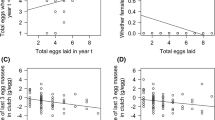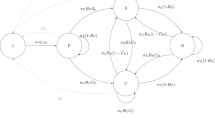Summary
Synchronized breeding in social units of animals (like colonies and herds) is often interpreted as a strategy against predators (predator satiation), and one might expect to find little variation in the relative date of starting reproduction. However, data on many colonies or herds show only partial synchrony. Our hypothesis is that this is not simply unavoidable variance but may be an adaption against predators. We consider the case where the members of a social unit can avoid predation actively by cooperation. If the contribution to this predator avoidance is different for individuals engaged in different phases of reproduction, our model shows that partial synchrony is of adaptive significance. Data on the black-headed gull (Larus ridibundus) are used to test the model's predictions.
Similar content being viewed by others
References
Ashmole, N. P. (1962) The Black Noddy,Anous tenuirostris, on Ascension Island.Ibis 103, 235–73.
Brandl, R. Warum leben einige Vogelarten in Kolonien? Beziehungen zwischen Koloniegröße, Nahrungsressource und Verhalten am Beispiel der Lachmöwe.Verhandlungen der ornithologischen Gesellschaft in Bayern 24, in press.
Brown, R. G. B. (1967) Breeding success and population growth in a colony of Herring and Lesser Blackbacked Gulls,Larus argentatus andL. fuscus.Ibis 109, 502–15.
Burger, J. (1976) Nest density of the black-headed gull in relation to vegetation.Bird Study 23, 27–32.
Cooper, J. A. (1978) The history of breeding biology of the Canada Geese of Marshy Point, Manitoba.Wildlife Monographs, No. 61.
Darling, F. F. (1938)Bird Flocks and the Breeding Cycle. Cambridge University Press, Cambridge, UK.
Findlay, C. S. and Cooke, F. (1982a) Breeding synchrony in the Lesser Snow Goose (Anser caerulescens caerulescens). I. Genetic and environmental components of hatch date variability and their effects on hatch synchrony.Evolution 36, 342–51.
Findlay, C. S. and Cooke, F. (1982b) Synchrony in the Lesser Snow Goose (Anser caerulescens caerulescens). II. The adaptive value of reproductive synchrony.Evolution 36, 786–99.
Flegg, J. J. M. and Cox, C. J. (1975) Mortality in the black-headed gull.Brit. Birds 68, 437–49.
Glutz, U. N. von Blotzheim and Bauer, K. M. (1982)Handbuch der Vögel Mitteleuropas, Vol. 8. Akademische Verlagshandlung, Wiesbaden.
Gochfeld, M. (1980) Mechanisms and adaptive value of reproductive synchrony in colonial seabirds. InBehavior of Marine Animals (J. Burger, B. L. Olla and H. E. Winn, eds) pp. 207–70. Plenum Press, New York, USA.
Gorke, M. and Brandl, R. (1986) How to live in colonies: spatial foraging strategies of the black-headed gull.Oecologia 70, 288–90.
Hamilton, W. D. (1971) Geometry of the selfish herd.J. Theor. Biol. 31, 295–311.
Kruuk, H. (1964) Predators and anti-predator behaviour of the black-headed gull (Larus ridibundus).Behaviour (Suppl.)11, 1–129.
Lofts, B. and Murton, R. K. (1973) Reproduction in birds. InAvian Biology (D. S. Farner and R. J. King, eds) pp. 1–107. Academic Press, NY, USA.
Maynard Smith, J. (1978) Optimization theory in evolution.Ann. Rev. Ecol. Syst. 9, 31–56.
Nisbet, I. C. T. (1975) Selective effects of predation in a tern colony.Condor 77, 221–6.
Parsons, J. (1972) Egg size, laying date and incubation period in the Herring Gull.Ibis 114, 536–41.
Patterson, I. J. (1965) Timing and spacing of broods in the Black-headed Gull (Larus ridibundus).Ibis 107, 433–59.
Pierre, D. A. (1969)Optimization Theory with Applications. John Wiley, London, UK.
Raveling, D. G. (1978) Timing of egg laying by northern geese.Auk 95, 294–303.
Reed, J. and Stenseth, N. (1984) On evolutionarily stable strategies.J. Theor. Biol. 108, 491–508.
Stenseth, N. (1985) On the evolution of cannibalism.J. Theor. Biol. 115, 161–77.
Ytreberg, N-J. (1956) Contribution to the breeding biology of the black-headed gull in Norway.Nytt Magazin of Zoology 4, 5–106.
Author information
Authors and Affiliations
Rights and permissions
About this article
Cite this article
Wissel, C., Brandl, R. A model for the adaptive significance of partial reproductive synchrony within social units. Evol Ecol 2, 102–114 (1988). https://doi.org/10.1007/BF02067271
Issue Date:
DOI: https://doi.org/10.1007/BF02067271




